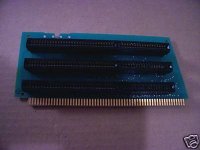I came across an auction for a Model 30-286, it seems the same as a diagram I found for the Model 25-286 board and I was toying with the idea of swapping out my Model 25 8086 board for it. In the interest of cost, I assume IBM manufactured only one type of Model 25/30-286 board and simply dumped them into whichever case they wanted, meaning that the ISA riser would line up in my case. My Model 25 is the MCGA version, so I am making another assumption that VGA would have no issues syncing with the monitor. The computer I'm typing this on still supports 720k drives in BIOS, so I'm sure an AT-class system won't have issues with them.
Am I on the right track here? My whole idea falls apart if the motherboards for Model 25-286 systems and Model 30-386 systems are different.
Am I on the right track here? My whole idea falls apart if the motherboards for Model 25-286 systems and Model 30-386 systems are different.


